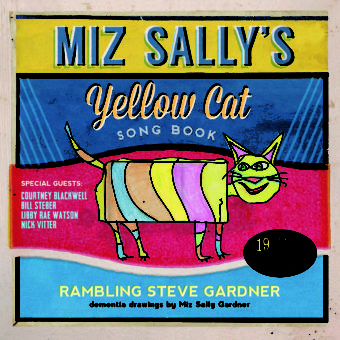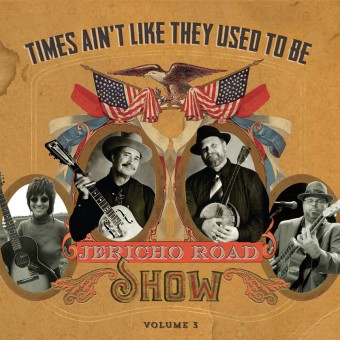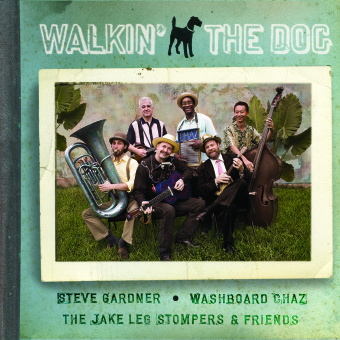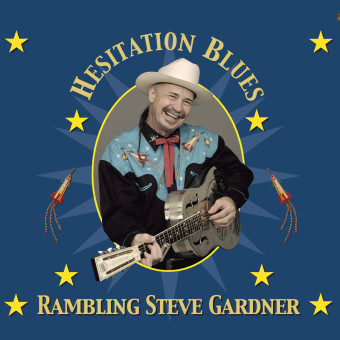
Album Description
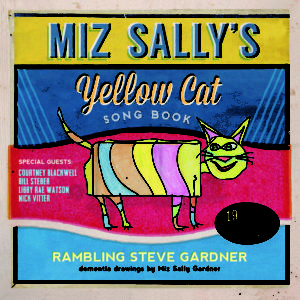
MIZ SALLY’S YELLOW CAT SONG BOOK
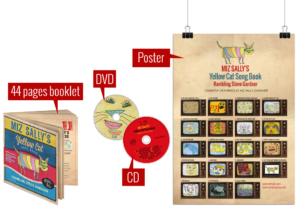
Miz-Sally-all-products-
“Miz Sally’s Yellow Cat Song Book” is about, and is for, my mom, MIZ SALLY. She is suffering with dementia. I put together all these songs and her drawings to bring her joy and comfort. I hope her “Yellow Cat Song Book” might give the same joy and comfort to others out there with Miz Sally’s same condition, and be helpful to their families and caregivers.
“Miz Sally’s Yellow Cat Song Book” is a double CD of 19 tracks of music, along with a 19-track music DVD animated with Miz Sally’s drawings. The CDs and DVD are packaged with several pages of Miz Sally’s drawings, the song lyrics and a poster.
The goal of “Miz Sally’s Yellow Cat Song Book” was to produce a selection of recordings that would have the feel of an afternoon of music played at home in the kitchen or the front room. Something familiar and fun. Something for Miz Sally. Something for all of us.
We hope that you will like “Miz Sally’s Yellow Cat Song Book” and will find a new favorite song, a new favorite drawing and a new way of sharing time with your loved ones. Try making drawings like Miz Sally’s as you sing along to the music or watch the DVD. More than anything else, we hope that you will find new joy in spending time with your loved ones who may have dementia, too.
The 19 audio tracks, recorded in August of 2016, were chosen by Miz Sally. If she liked a tune consistently after I played it for her more than ten times, over a period of months, and responded by saying, “Oh, I like that one,” I would keep it in the pile. Any songs that she wavered on were cast aside.
In choosing and arranging the music for this recording, I began with a selection of tunes that I heard growing up in the late 1950’s and early 1960’s. I turned first to the tunes that I remembered being played on old, out of tune guitars at square dances and fish fries or sung a cappella at church socials with “dinner on the ground.” We included a few of these for this collection.
Miz Sally responded best to the old tunes like “Polly Wolly Doodle” and “Cindy, Cindy” that she had heard when she was a child and that she played for us for hours on end before I began elementary school. We used to play stacks of old, scratchy, red and yellow 78 RPM records on the old phonograph at my grandmother’s house.
After choosing the best of these songs, I re-wrote and arranged them so they would be personal for Miz Sally (this is what I called my mom and I used her name whenever I could). Over time, I adjusted the tunings and pitch for her enjoyment of these tunes as I came to realize that Miz Sally’s dementia had changed her sensitivity to sounds, loud and soft, as well as to pitch, high and low. I shaped them to fit her.
For example, I tuned my National Reso-phonic 12 string guitar to low E or low B and my six string National Reso-phonics to low C or low F. On a few tracks I added a Cello for an extra low tone and avoided “sharp” hard-hitting percussion or extreme high tones, although we did use a musical saw on one track (it’s very mellow).
Watching Miz Sally’s frustrations and the many changes that have come over her as the dementia took a firmer hold on her mind, I wrote one song for this recording about her struggle to hold onto her memories and to musically address the question: “Where do memories go?”
“Bluebird Memory” is my image of Miz Sally’s life, her memories caught, down in a deep valley, between the devil and the deep blue sea. A hard place to find and an even harder place to get to. I have always heard that a bluebird could fly away like Noah’s dove and bring us back glad tidings, happy news and maybe even, memories that we thought were lost. Miz Sally seems to be waiting for her bluebird to bring her back a memory so that she can start all over again.
In the southern culture that I grew up in, the bluebird has always been a messenger and symbolized good fortune, both the literal bluebird, and the U.S. postal airmail “bluebird,” that thin single page of lined paper that folded over to form a self-sealing all-in-one-envelope-letter. Miz Sally wrote hundreds of those over the years and we received stacks of them in return from my Uncle Jack when he was away in the US Army back in 1961. He drew little cartoons inside of his, which Miz Sally always showed to us when they arrived. He signed his bluebird with a little drawing of a dog saying, “Love from your homesick hound dog.”
“Get Along Home Sally, Sally” is a song about the average day in Miz Sally’s life with dementia. The chorus goes, “Get along home, get along home. Get along home Sally, Sally everything’s gonna be alright.”
Miz Sally beamed the first time that she listened to it, tapping her foot and clapping her hands. With a big smile on her face she shouted, “That’s about me! He’s singing about me! He’s singing about Sally!” My sister Renee and I both were crying and laughing at the sight of Miz Sally enjoying herself so much while listening to “her song.” She didn’t want to stop and it was hard to get her to go to bed that night.
My sister, Renee Trusty, was the one who suggested creating a DVD combining both the music and Miz Sally’s drawings. She always has great ideas, so we did just that. Kermit Carvell and I animated the 19 tracks, which are mostly slide shows of Miz Sally’s drawings designed for viewing in an old box-style television frame.
Miz Sally, like many with dementia, does not see well and her reaction to the frameless, large-screen televisions, which project life-size images into the home, is often fear and confusion. She mistakes the screen images for strangers in the living room, so we decided to enclose those images into an old television frame so that it might “seem” more familiar.
This old box-style TV presentation makes it easy for someone with dementia to watch and may awaken some far distant memories of time long past, when images flickered across the screen of their old black and white TV set with aluminum foil wrapped around the rabbit ear antennas, picking up two and a half stations, filled with snow and horizontal lines.
Besides music and drawing, Miz Sally enjoys stories, too. The story “171 lb. Hog” is a story about the time that our family of four hauled a 171-pound hog from my grandmother’s house down in New Orleans back up to Summit, Mississippi in the trunk of a four door Fiat 1500. Miz Sally may not remember that time exactly, but she enjoys the story and the sounds in the present, and she laughs in all the right places.
Miz Sally can’t always connect words with the expression on her face but in her world of “the present” feelings count the most. She greets us in the mornings with a hug saying, “I’m so glad to see you,” as we give her a hot towel to press to her face which she enjoys to the fullest. She giggles with delight when pulling up the sheets of her warm bed before sleep or shivers and complains bitterly if her bed is too cold.
Miz Sally’s dementia has forced her to live very much in the present. Her grasp of even one minute into the past is loose at best and nonexistent on most days. This condition is frustrating for all. She forgets that she just ate, often cannot find her room and may not recognize it once she does find it.
When she is having a “good day,” Miz Sally seems to focus her full attention on the task at hand; whether it is wrestling with a bowl of Cheerios, petting her yellow cat or just getting her flip-flops to stay on her feet as she sits at the table holding out her hands admiring her red, manicured finger nails. That seems to be where her mind is but when asked she will have no idea where her mind was.
Sometimes Miz Sally’s mind gets caught-up in a loop, stuck on a thought or a question that she just can’t shake. A question which she might ask over and over, for hours at a time, without caring about the answer given. On a good day, we might find a way to distract her. On a bad day, even her favorite chocolate does no good. It is like her mind has traveled to some far off distant place and left her body behind in a mass of confusion. Music and drawings help her with all that.
My sister, Renee Trusty, is the primary caregiver for Miz Sally. Words fail me and I cannot express my heartfelt thanks enough to her and her family. Her husband, Mark and youngest daughter, Savannah, share their home, their time and take part with Renee in the hard work of caring for Miz Sally. I appreciate their support too. In spite of the loss of our dad, Big Steve, in 2013 and Miz Sally’s dementia, Renee has managed the task of caregiving and homemaking along with running her own business. She’s a marvel.
“MIZ SALLY’S YELLOW CAT SONG BOOK” is dedicated to my sister, RENEE TRUSTY, along with all the other CAREGIVERS out there, who just like her, are working day in and day out giving their all.
In my book, CAREGIVERS are the real heroes in this world. Thank YOU for all that YOU do.
“MIZ SALLY’S YELLOW CAT SONG BOOK” is my personal project which began at home, with Miz Sally and my family. But the goal is to help throw open the locked doors of dementia by sharing our high and low times, our music and Miz Sally’s drawings. This is our small offering of hope and sunshine to a world that can be very dark and hopeless for both the caregiver and family members as well as the loved one suffering with dementia.
As is often said, “Life gets in the way while we are making plans.” The lesson we learned with Miz Sally is to be sure to make plans to spend more time to laugh, love, play music, sing and dance. Life is short so make plans to spend it with those you love. Do the things that make you happy. It is the little things that add up to the greatest value. A life well lived is not measured by the number of coins in the bank but the number of great memories.
Big Leg Thanks ALL AROUND to those of you out there who have lifted us up when we were down, pitched in, shouted out an encouraging word, sang along, played music, threw beads and money, bought meals, shared medical information as well as your own stories, suggestions, and hugs, and who laughed in all the right places!
The lights and the music, like the flowers of our memories, fade. And way too soon, we too, will more than likely be caught, “Deep down in the valley, lost, between the devil and the deep blue sea, waiting for a bluebird to bring us a memory”.
Make it a good one!
Rambling Steve Gardner
2016
There is much MIS-information about DEMENTIA. Here are Five Myths about dementia that may be helpful to you and yours along with three very useful links on caregiving.
Rosalynn Carter Institute For Caregiving: www.rosalynncarter.org
Mayumi Nakazawa: blog.goo.ne.jp/mayucat2
Debbie Howard: www.thecaregivingjourney.com
By Rachel Schindler, MD | Sep 4, 2014
MYTH: Dementia is a disease
FACT: Dementia is not a disease. Instead, it describes a group of symptoms that affects the ability to think, remember things, and reason to a degree such that a person’s activities of daily living are impaired. Other changes can include trouble with language or communication, and unexpected changes in mood and behavior.
MYTH: All types of dementia are the same
FACT: There are many different types of dementia—though some are more common than others. Some of the more common types of dementia include:
- Alzheimer’s dementia (AD): This is the most common and most well-known cause of dementia. It is a progressive disease that slowly changes the chemistry and structure of the brain, leading to the death of brain cells. Becoming confused and forgetful and experiencing mood swings are common with AD
- Parkinson’s dementia: Though Parkinson’s disease first affects the region of the brain that is key to movement, it eventually spreads and can begin to affect mental abilities. Parkinson’s dementia affects memory, attention-span and judgment, and can look a lot like AD
- Vascular dementia: This type of dementia occurs when the oxygen supply to the brain is cut off due to a stroke or a series of mini-strokes. It is a common form of dementia and can cause problems with speed of thinking, concentrating and ability to complete tasks
- Lewy Body dementia: This type of dementia gets its name from protein aggregates that develop inside the nerve cell and cause damage to tissues. With Lewy body dementia, attention and alertness problems are common, as are hallucinations
- Frontotemporal dementia: This dementia is caused by damage to the front part of the brain. It can affect personality and lead to behavioral changes and eventually memory problems
MYTH: Losing your memory and getting confused is a natural part of aging
FACT: Dementia is common in the aging population. But it is not a normal or natural part of aging. In other words, something that is common is not the same as something that naturally happens due to aging. It may be true that as we get older we may get less physically and mentally agile, which is why it is important to stay active. It’s important to choose foods and activities that are both heart healthy and brain healthy. Speak with your doctor to better understand if you may have dementia, what type it may be, and how it can be addressed.
MYTH: Dementia is usually diagnosed shortly after the onset of Alzheimer’s disease
FACT: Dementia-causing disease can be present as much as 20 years before symptoms of dementia begin to occur. The first signs of disease are often very mild forms of cognitive (learning or memory) impairment and may be too subtle to cause concern.
MYTH: You can tell that someone has dementia because they are unable to communicate and usually live in an assisted living facility or nursing home
FACT: The progression of dementia due to Alzheimer’s is gradual, so many people with dementia may be out in the world, some living independently with moderate help, and managing their lives.
Rachel Schindler, MD is a physician/scientist who leads the strategy for Neuroscience in the Clinical Sciences group at Pfizer’s Global Innovative Pharmaceuticals Medicines Development Group. She is the founder and former Director of the Neurobehavior and Memory Disorders Center at University Hospital at Stony Brook.
Rambling Steve Gardner
Miz Sally’s Yellow Cat Song Book
2017 Blues Cat Records
RECORDING INFO:
Produced by: Rambling Steve Gardner
Recorded August 2016: Vitter Studios New Oleans, LA.
Engineering, mixing and mastering all tracks: Nick Vitter
Art Director: Marco Mancini
Cover Illustration: Sharisse Steber
Drawings: Miz Sally Gardner
Photography/Art scans: James Patterson
Additional photography: Pat Casey Daley, Rambling Steve Gardner
Video Producer: Kermit Carvell / Last Hero Productions
Video Mastering: Rob Moreno Video Producer Media Sense
Text Editor: Michael Pronko Raked Gravel Press
Dementia/Care Advisor: Mayumi Nakazawa author of “O Hitori-Sama”
Printing/Pressing:
Taiwan Coordinator: David Chen/Muddy Basin Ramblers
MUSICIANS
Rambling Steve Gardner- Vocals,National Reso-phonic 6/12 string Guitars, Slide, River Boat Banjo, Harmonica
Courtney Blackwell- Cello Tracks 2,7,8,9
Bill Steber- Backing Vocals, Saw, Banjo Uke Tracks 8,10,11
Libby Rae Watson- Backing Vocals Track 10
Nick Vitter- Piano, Mallet Bass Track 5,16
CONTACTS:
Rambling Steve Gardner: ramblingstevegardner@gmail.com
Homepage: www.ramblingsteve.info
Courtney Blackwell: cgk2002@hotmail.com
Bill Steber: bill@steberphoto.com
Libby Rae Watson: www.facebook.com/libbyrae
Nick Vitter/ Vitter Studios: nvitter@gmail.com
James Patterson Photography: james@119gallery.com
Marco Mancini: mmancini@magnetjazz.net
Sharisse Steber: sharisse@sharissedesign.com
Kermit Carvell / Last Hero Productions: www.tmpcarol.com
Rob Moreno: moreno@mskk.com
Michael Pronko: www.michaelpronko.com
Mayumi Nakazawa: blog.goo.ne.jp/mayucat2
Pat Casey Daley: www.steberphoto.com
David Chen: www.muddybasin.com
National Reso-phonic Guitars: shanon@nationalguitars.com
BLACK SIGN Top Notch Garments: www.blacksign.jp
WWOZ: www.wwoz.org
Awesome AM 960: www.awesomeam.com
Rosalynn Carter Institute For Caregiving: www.rosalynncarter.org
Debbie Howard: www.thecaregivingjourney.com
Big Leg Thank You’s and X-tra Large Shout Outs!
Long time friends who lent support to Miz Sally’s Yellow Cat Song Book: Kako Saito, Mike Maksimuk, Pat Casey D., Euphus Ruth, Wes Lee & family, Barbara Hancock/ MediaSense, Dr. Martha Melton Colvin, Paul Cohen, Trish Berry & The Blue Biscuit (Indianola), Squealers (Meridian), The Temple Theatre, James Dickerson/Sartoris Literary Group, Renee Trusty’s Bunko Ladies, St. Charles Guest House, Tak Karasawa Pan Project, (Small LOGO) All of the great folks over at National Reso-phonic guitars, (Small LOGO) Mr. Takanori Okamoto of BLACK SIGN Top Notch Garments (JP), Peggy Lou and WWOZ 90.7 FM along with James Poe WABG Awesome 960 AM.
For Bookings/Information
Rambling Steve Gardner
ramblingstevegardner@gmail.com
www.ramblingsteve.info

